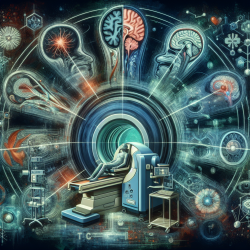Unlock the Secrets of Visual Deficits: How MRI Can Transform Your Practice!
As a special education director, staying informed about the latest research and technological advancements is crucial for providing effective leadership and support to both educators and students. One such advancement that has been making waves in the field of neuroscience and vision research is the use of magnetic resonance imaging (MRI) to assess visual deficits. This blog will delve into the findings from the research article "Using magnetic resonance imaging to assess visual deficits: a review" and explore how practitioners can enhance their skills by integrating these insights into their practice.
Revolutionizing Vision Research with MRI
Over the past two decades, MRI has become a pivotal tool in neuroscience research, offering a non-invasive method to examine the brain's structure and function. This technology has been particularly transformative in vision research, allowing scientists to explore the effects of eye diseases on the entire visual pathway, from the eye to the brain. The review article highlights several key findings that underscore the potential of MRI in understanding and addressing visual deficits.
Key Findings and Implications
- Structural Abnormalities: MRI studies have identified significant abnormalities in both grey and white matter densities across visual and non-visual areas. These structural changes are particularly evident in conditions such as amblyopia, macular degeneration, and glaucoma.
- Functional Changes: Functional MRI (fMRI) has provided extensive evidence of functional changes throughout the visual pathway following visual loss. This is especially pronounced in amblyopia, where altered connectivity and reduced activity in specific brain regions have been observed.
- Neurochemical Insights: Magnetic resonance spectroscopy (MRS), a technique related to MRI, has revealed abnormalities in metabolite concentrations in conditions like glaucoma and age-related macular degeneration. These findings suggest potential avenues for therapeutic interventions targeting neurochemical pathways.
Enhancing Practitioner Skills
For practitioners working with students with visual deficits, integrating MRI findings into practice can offer several benefits:
- Improved Diagnosis: MRI can aid in the early detection of visual deficits, allowing for timely interventions and tailored educational strategies.
- Targeted Interventions: Understanding the specific structural and functional changes associated with different visual deficits can guide the development of targeted therapeutic approaches, enhancing the effectiveness of interventions.
- Personalized Education Plans: By incorporating MRI insights, educators can design personalized education plans that accommodate the unique needs of students with visual impairments, fostering a more inclusive learning environment.
Encouraging Further Research
While the current findings are promising, further research is needed to fully understand the implications of MRI in vision research. Practitioners are encouraged to stay informed about ongoing studies and consider collaborating with researchers to explore new avenues for improving outcomes for students with visual deficits.
To read the original research paper, please follow this link: Using magnetic resonance imaging to assess visual deficits: a review.










